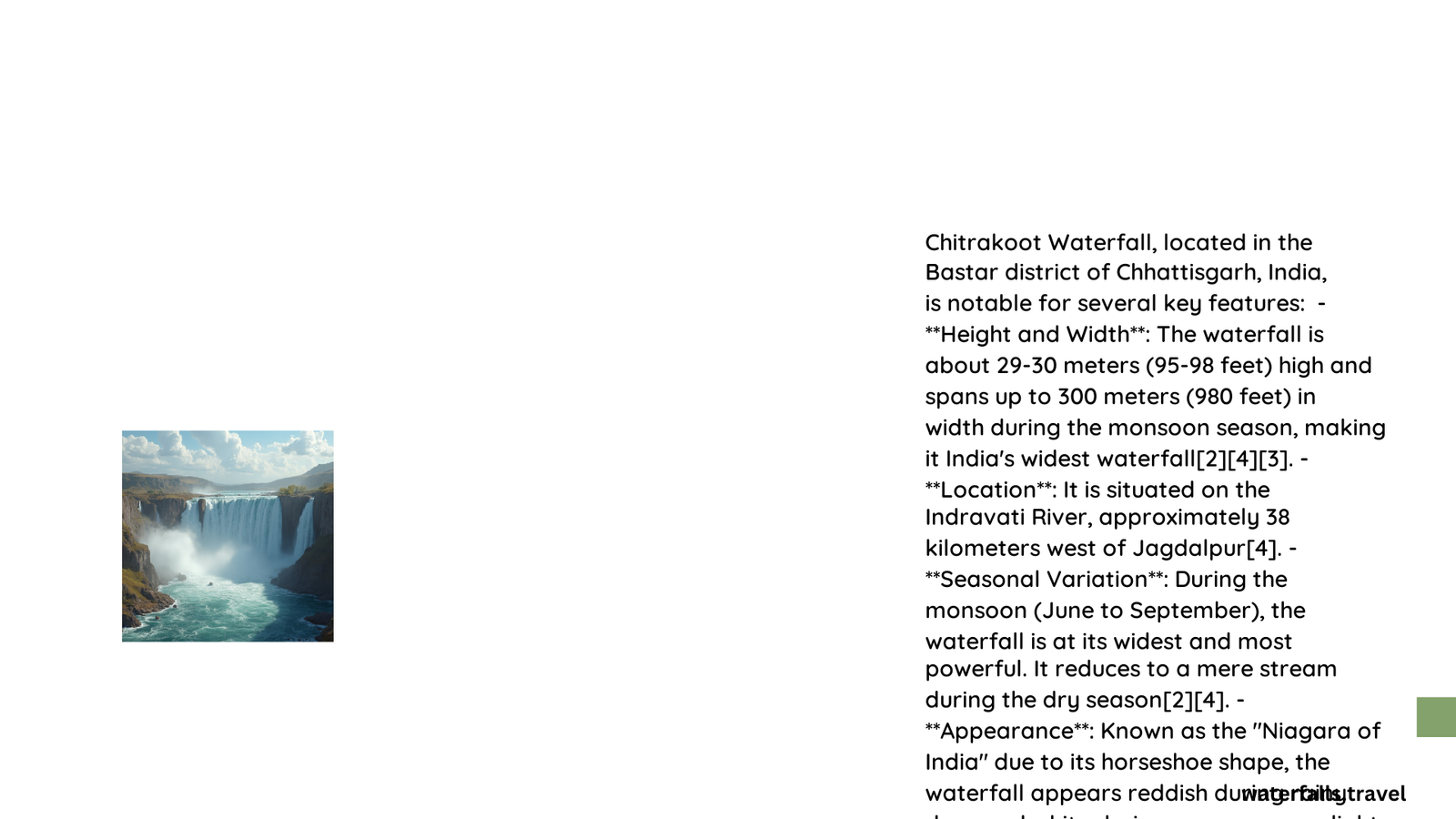Chitrakoot Waterfall, known as the ‘Niagara of India’, is a majestic 29-30 meter high waterfall located on the Indravati River in Chhattisgarh’s Bastar district. This natural wonder holds cultural and religious significance, with ties to Hindu mythology and local tribal communities. The waterfall’s appearance varies seasonally, offering different experiences throughout the year. This guide provides comprehensive information about Chitrakoot Waterfall, including its history, visiting details, and travel tips.
What is the Historical Significance of Chitrakoot Waterfall?
Chitrakoot Waterfall, often called the ‘Niagara of India’, is steeped in historical and cultural significance:
- Location: Situated on the Indravati River in Bastar district, Chhattisgarh
- Formation: Created by the Indravati River plunging off a 29-30 meter (96-98 feet) cliff
- Cultural Importance: The surrounding area is believed to have been a meditation spot for Lord Rama during his exile
- Religious Sites: The region features numerous temples and shrines, including the historic Danteshwari Temple
- Tribal Significance: Revered by local indigenous communities such as the Gond, Maria, and Muria tribes
While not directly mentioned in Hindu scriptures, the waterfall’s name “Chitrakoot” is associated with another location linked to Lord Rama’s exile. However, this Chhattisgarh waterfall has its own local legends and sacred status among indigenous communities.
What are the Visiting Hours for Chitrakoot Waterfall?

The visiting hours for Chitrakoot Waterfall are flexible, but consider the following:
- General Access: Open throughout the day
- Recommended Time: Daylight hours for the best viewing experience
- Seasonal Variations:
- Monsoon Season (July to October): Waterfall at its peak, powerful and thunderous
- Dry Season: Reduced to a stream, but still accessible for activities like boat rides and swimming
When is the Best Time to Visit Chitrakoot Waterfall?
The optimal visiting time depends on your preferences:
- Monsoon Season (July to October)
- Pros: Waterfall at its fullest and most impressive
-
Cons: Potential risks due to heavy rains and strong currents
-
Post-Monsoon (October to February)
- Pros:
- Moderate water flow
- Pleasant weather
- Suitable for outdoor activities
- Cons: Less dramatic waterfall compared to monsoon season
Choose based on whether you prefer a more spectacular view or safer, more comfortable conditions.
How to Plan Your Visit to Chitrakoot Waterfall?
Accommodation Options
| Type | Description | Location |
|---|---|---|
| Budget Hotels | Affordable stays | Jagdalpur |
| Mid-range Resorts | Comfortable options | Jagdalpur |
| Eco-friendly Resorts | Nature-focused stays | Near the falls |
| Guesthouses | Local experience | Near the falls |
Food and Dining
- Local eateries in Jagdalpur offer authentic cuisine
- Restaurants provide a range of dining options
Transportation
- Well-connected by road from major cities in Chhattisgarh and neighboring states
- Jagdalpur serves as the main gateway to the falls
Activities Available
- Boat Rides (during calmer months)
- Trekking in surrounding forests
- Nature Photography
- Swimming in natural pools (during drier months)
- Cultural experiences:
- Learning about local tribal culture
- Exploring tribal arts and crafts
- Visiting ancient temples and archaeological sites
Costs and Fees
- Waterfall visit: Generally free
- Additional activities (boat rides, guided tours): May incur charges
- Accommodation costs vary based on type and season
Rules and Regulations
- Keep the surroundings clean
- Respect the natural beauty and local culture
- During monsoon, follow local safety guidelines due to strong currents
What Should Visitors Know About the Local Culture?
Understanding the local culture enhances the Chitrakoot Waterfall experience:
- Indigenous Communities: The area is home to Gond, Maria, and Muria tribes
- Tribal Arts: Visitors can explore unique tribal art forms and crafts
- Festivals: Local tribal festivals offer insights into traditional customs
- Sacred Sites: Numerous temples and shrines dot the landscape, reflecting the region’s spiritual significance
How Accessible is Chitrakoot Waterfall for Different Types of Travelers?
Accessibility varies depending on the traveler:
- General Tourists: Well-connected by road, suitable for most visitors
- Adventure Seekers: Opportunities for trekking and exploring surrounding forests
- Families: Safe for family visits, especially during post-monsoon season
- Elderly or Mobility-Impaired: May face challenges due to natural terrain; limited facilities for accessibility
What are the Photography Opportunities at Chitrakoot Waterfall?
Chitrakoot Waterfall offers diverse photography subjects:
- Landscape Photography: Capture the majestic waterfall in various seasons
- Wildlife Photography: Surrounding forests host diverse flora and fauna
- Cultural Photography: Document local tribal life and traditions
- Macro Photography: Focus on unique plant species and insects in the area
Best times for photography:
– Early morning: Soft light and potential mist
– Golden hour: Dramatic lighting on the waterfall
– Monsoon season: Powerful water flow for dramatic shots
How Does Chitrakoot Waterfall Compare to Other Indian Waterfalls?
Chitrakoot Waterfall stands out among Indian waterfalls:
- Size: One of the widest waterfalls in India
- Cultural Significance: Strong ties to local tribal communities
- Seasonal Variation: Dramatic changes between monsoon and dry seasons
- Accessibility: Relatively easy to reach compared to some remote waterfalls
- Surrounding Ecosystem: Rich biodiversity in the surrounding Bastar region
This unique combination of features makes Chitrakoot Waterfall a must-visit destination for nature lovers and cultural enthusiasts alike.
